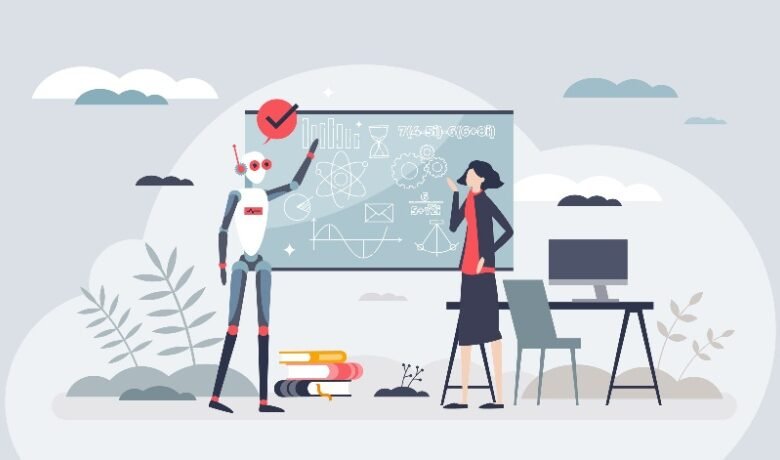
Teachers And AI: Balancing Technology And The Human Touch
The global AI in education market, which is expected to be valued at $5.57 billion in 2024 [1], has a bright future, with projections that it could reach $30 billion by 2032 [2]. Some of the key reasons for this remarkable growth include the increasing use of digital learning platforms, a rising focus on personalized learning, a growing shift to adaptive learning systems, the use of learning analytics to drive decision-making, and the demand for AI-powered tutoring systems. Yet, concerns regarding AI replacing human teachers are very real. After all, we’ve seen the power of generative AI in mimicking human interactions. Plus, AI-powered personal assistants are proving invaluable in supporting students in the absence of teachers, answering questions, offering suggestions, and providing content recommendations. Against this backdrop, it is crucial to understand the benefits of AI in education, not just for students but also for teachers.
Common Fears About AI Replacing Teachers
As technology advances and grows to play a pivotal role in education delivery, a revolution in teaching and learning methodologies is only to be expected. Adopting new technologies has traditionally led to some resistance to change, and not just among teachers. But when technology appears to have the power to do your job, some fears are only natural, such as:
- Concerns regarding job security.
- Dehumanization of the classroom experience.
- The adverse impact of over-reliance on technology on learners’ critical thinking skills.
- Potential bias in AI algorithms, given that these algorithms work only as well as the data they are trained on.
However, the fact is that AI is still far behind humans, especially in terms of socio-emotional skills. So, AI tools can prove to be powerful partners for educators, rather than their replacement.
How AI In Education Can Empower Teachers
The benefits of AI for teachers encompass a wide range of educator responsibilities, such as:
1. Handling Administrative Tasks
- AI-powered grading systems not only evaluate assessments based on multiple-choice, FIB, order matching, etc., but they can also grade long-form answers, analyzing grammar, syntax, and content.
- Student attendance records can be maintained by AI-powered tracking of logins to the digital learning platform.
- AI/ML-powered data analytics and custom report generation can help teachers keep track of students’ learning progress and communicate the same to all stakeholders, including parents.
These AI tools free up teachers’ time, which can then be used to focus on adding value, such as delivering personalized learning and differentiated instruction. The best part is that educators can review the tasks completed by AI and make changes as and when required. The end result is that AI benefits education by reducing teachers’ workloads.
2. Delivering Personalized Learning
Through data analytics, AI supports teachers in gaining insights into the learning needs and goals of individual students while also identifying their strengths and weaknesses. In addition, the technology is known to provide relevant content recommendations. Together, these capabilities can empower teachers to tailor personalized learning paths and adapt instruction to each learner.
3. Providing Differentiated Instruction
AI can also be a powerful tool as we move from a one-size-fits-all approach to education to ensuring inclusivity and accessibility. With the power of AI, teachers can ensure multilingual support, choice of content formats to suit different students’ needs, and much more. Teachers can ensure video captioning for students with hearing impairments while providing visually impaired learners with text-to-speech tools. In fact, teachers can ensure anytime, anywhere learning so that students with limited access to internet connectivity or devices do not fall behind the rest.
Adaptive learning platforms are playing a key role in promoting differentiated instruction, tracking student data to enable educators to provide support when and where needed, and directing each student to the most relevant learning materials.
The Human Element Remains Irreplaceable
Despite the multiple benefits AI offers teachers and students in education, the technology does not undermine the value teachers add to students’ personal development. Teachers aid by offering mentorship, motivation, and learning facilitation. AI cannot substitute for the human connection, empathy, and social-emotional skills teachers bring to the classroom. Teachers also facilitate learning while encouraging creativity and critical thinking.
Teachers can leverage AI insights into students’ challenges to address them at a personal level. They can facilitate an environment that promotes teamwork. Moreover, teachers foster curiosity in students by using AI to provide life-like experiences. In fact, the collaboration between AI and teachers is key to unlocking value for learners.
The Future Of AI In Education
AI in education is set to make learning more interactive, simple, inclusive, and accessible for everyone. It has already proven its worth in delivering personalized learning and differentiated instruction while lowering teachers’ workloads.
Going forward, VR and AR tools powered by AI can create immersive learning experiences, allowing students to practice their knowledge in real-world situations without the risks associated with real-life practice. AI is already being used by several educational institutions to provide immediate feedback on formative assessments. As technology advances, it is likely to support more personalized assessment and feedback to enhance learning outcomes. Adopting an AI-powered digital learning platform that addresses multiple educational needs can give EdTech companies and educational institutions a competitive edge.
References
[1] AI in Education Global Market Report 2024 [2] Artificial Intelligence (AI) in Education Market size to exceed $30 bn by 2032Source link





